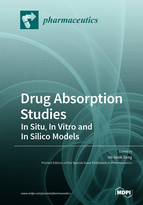Drug Absorption Studies: In Situ, In Vitro and In Silico Models
A special issue of Pharmaceutics (ISSN 1999-4923). This special issue belongs to the section "Biopharmaceutics".
Deadline for manuscript submissions: closed (31 March 2021) | Viewed by 34854
Special Issue Editor
Interests: pharmacokinetic drug–drug interaction; pharmacokinetic herb–drug interaction; drug-metabolizing enzymes and transporters; pharmacokinetic/pharmacodynamics in drug development; oral bioavailability
Special Issues, Collections and Topics in MDPI journals
Special Issue Information
Dear Colleagues,
Since oral administration of drugs remains the route of choice for numerous drugs, intestinal permeability of orally administered drugs has been widely used to determine the rate and extent of intestinal absorption of drugs. Solubility, dissolution, and gastrointestinal physiology, including transit, pH condition, and mechanisms for gut metabolism and transport, could also affect the intestinal absorption of orally administered drugs.
Several strategies have been developed to estimate the oral bioavailability of drugs and to understand or overcome the issues associated with low oral bioavailability. The implementation of in situ, in vitro, and in silico methods, followed by in vivo evaluation, can guide to obtain the acceptable oral bioavailability in the drug development and formulation process.
This Special Issue aims to highlight the mechanisms related to low intestinal drug absorption, the strategies to overcome the obstacles or intestinal drug absorption, and in situ, in vitro, and in silico methodologies to predict intestinal drug absorption.
Prof. Dr. Im-Sook Song
Guest Editor
Manuscript Submission Information
Manuscripts should be submitted online at www.mdpi.com by registering and logging in to this website. Once you are registered, click here to go to the submission form. Manuscripts can be submitted until the deadline. All submissions that pass pre-check are peer-reviewed. Accepted papers will be published continuously in the journal (as soon as accepted) and will be listed together on the special issue website. Research articles, review articles as well as short communications are invited. For planned papers, a title and short abstract (about 100 words) can be sent to the Editorial Office for announcement on this website.
Submitted manuscripts should not have been published previously, nor be under consideration for publication elsewhere (except conference proceedings papers). All manuscripts are thoroughly refereed through a single-blind peer-review process. A guide for authors and other relevant information for submission of manuscripts is available on the Instructions for Authors page. Pharmaceutics is an international peer-reviewed open access monthly journal published by MDPI.
Please visit the Instructions for Authors page before submitting a manuscript. The Article Processing Charge (APC) for publication in this open access journal is 2900 CHF (Swiss Francs). Submitted papers should be well formatted and use good English. Authors may use MDPI's English editing service prior to publication or during author revisions.
Keywords
- Oral bioavailability
- Intestinal absorption
- Intestinal permeability
- Gut metabolism
- Efflux transporters
- BCS (Biopharmaceutical classification system)
- Dissolution test
- IVIVC (In vitro to in vivo correlation)







